
Vol 90 No 38 - October 7, 2013
Nights among the Stars at the 3.5m WIYN Telescope
Presented By: Catherine Pilachowski, PhD, Astronomy, Daniel Kirkwood Chair in Astronomy, IU Bloomington
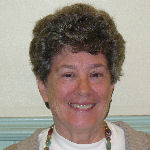
Catherine Pilachowski
Our talk today was presented by Professor Catherine A. Pilachowski, PHD (Katee) (catyp@astro.indiana.edu). Dr. Pilachowski investigates the evolution of stars and the chemical history of the Milky Way Galaxy from studies of the chemical composition of stars and star clusters. Dr. Pilachowski received her PHD in astronomy from the University of Hawaii in 1975. She is the Kirkwood Chair Professor of Astronomy at Indiana University, Bloomington. She has served as Astronomy Department Chair at IU and as the director of Kitts Peak National Observatory.
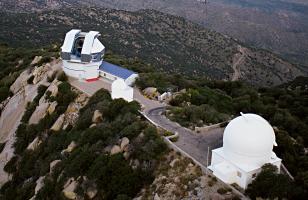
Telescope Location
The WIYN Observatory is owned and operated by the WIYN Consortium. Its telescope, a 3.5-meter instrument, is the newest and second largest telescope on Kit Peak in Arizona. Most of the capital costs of the observatory were provided by the University of Wisconsin-Madison, Indiana University, and Yale University, while the National Optical Astronomy Observatory provides most of the operating services. The telescope is located 35 miles SW of Tucson, Arizona at 7,000 ft. This site offers the clearest air, and the largest number of cloud-free days in the lower 48 states. The location has many other telescopes, the first of which dates back to 1958. Construction of the WIYN telescope was started in 1990 and completed in 1995. It was the first telescope to using modern design to lower the cost. It is located on the top of a hill that gives a clear view for 50 miles in all directions, and is also located right on the edge of a very large cliff. By having the telescope on the cliff, there is a smooth flow of air from one direction.
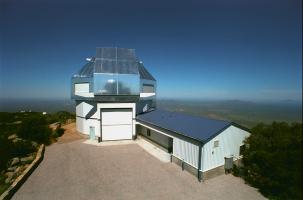
Telescope Exterior
The building housing the telescope is octagonal which allows the night air to enter the telescope building from all directions. The air in the rest of the building is vented by a large duct to a site which is distant from the telescope. The movement, and temperature of the air are important for quality images.
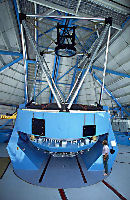
WIYN Telescope
The 3.5 meter mirror was cast on a rotating wheel in a furnace. The mirror was produced in Arizona, and took 2 years to polish. The mirror has a surface smoothness of 10-9 meters. The focal ratio of the mirror is F1.5 and is on an axis that points straight up. Small pistons push on many points of the mirror as it is turned to compensate for the effect of gravity on the glass.
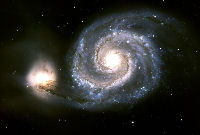
Whirlpool Galaxy
The Hubble space telescope provides excellent images, but has limited light gathering ability due to its size of 2.5 meters. Also, the Hubble's cost currently exceeds 8 billion dollars. This is the reason more telescopes are being placed on the earth's surface using new technologies like the WIYN. Present research includes how stars make elements, and how these elements move into the universe. A new wide field image camera with 140 mega pixels is currently being used and this will soon be upgraded to a 300 mega pixel camera.
IU shares the expenses (17%) of the facility, getting a commensurate amount of time to use the telescope. Yet trouble is in the future for the WIYN. Three members of the consortium will stop their funding in 2 years, causing a 65% budget cut. Dr. Pilachowski looks forward to continued research, but with the extra burden of finding new partners to help fund the $1.5 million a year annual budget for the upkeep of the telescope.
Dr. Pilachowski provided the audience with wonderful pictures of space, and was able to show the effects of what technology has and is doing for image quality. We hope to have Dr. Pilachowski back in the future.
Notes by Hank Wolfla
Vol 90 No 39 - October 14, 2013
Forestry in Indiana: woodland management and the lumber industry
Presented By: Mike Warner, Forester
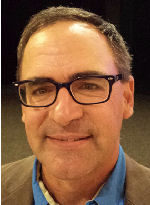
Mike Warner
Mike Warner is a 1976 Purdue graduate, president of ArborTerra Consulting, Inc., and has planted 40,000 hardwood trees on Bob Picketts' family tree farm.
Indiana has 4.7 million acres of forestland, which equals 20% of Indiana's land. Indiana forests are growing in volume at 3.8 times the amount being removed. Timberland has increased in Indiana from 3.896 million acres in 1967 to 4.631 million in 2008. Historically, in the 18th Century 95% of Indiana was covered with forests. The state was virtually deforested in the 19th Century due to agriculture and wood burning.
Concerted efforts to reforest began in the 1940s with the Citizens Conservation Corps. Since then, government has provided incentives to farmers to convert cropland to forest. The state has a program of property tax reduction for maintaining forestland.
95% of Indiana forests are primarily hardwood, 3.4 million acres oak/hickory and 1.4 million beach/maple. There are approximately 190,000 private landowners of timberland in Indiana, which accounts for 87% of our timberland. The number of private owners has been increasing, as in 1978 there were only about 50,000 private owners. The number is increasing not because of increased forestland; rather it is due to forestland being fragmented by property division.
The forest industry in Indiana employs 35,000 persons. 86,139 additional jobs are generated supporting or supported by the hardwood industry. Indiana ranks 9th nationally in total lumber production and third in hardwood lumber production. Forest products are the 6th largest industry in Indiana.
The industry faces challenges. Foremost are invasive species such as the ash borer and Asian bush honeysuckle. Urban sprawl continues to gobble up forestland.
It is vital that our tree population is maintained, because trees produce oxygen and all of us need it.
Notes by Jeff Rasley
Vol 90 No 40 - October 21, 2013
Hiking the Appalachian Trail in 6 Ĺ months
Presented By: Jim Dashiell, MD, Retired Orthopedic Surgeon
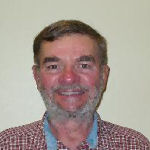
Dr. Jim Dashiell
Funnybones Appalachian Trail Story 3-26-2012 to 10-6-2012
Dr. Dashiell is a retired orthopedic surgeon who practiced in Indianapolis, Noblesville and Tipton Indiana. He received his education and training at Wabash College, Indiana University School of Medicine, Wishard Hospital and the Indiana University Medical Center.
The Appalachian National Scenic Trail generally referred to as the Appalachian Trail or simply the A.T. is a marked hiking trail in the eastern United States extending between Springer Mountain in Georgia and Mt. Katahdin in Maine. It is approximately 2180 miles in length extending through 14 states. The trail was originally conceived by Benton Mackey in 1921 and developed over the next several decades. Dr. Dashiell had several reasons to undertake the arduous journey including a major personal test. In addition he did raise $4000 for a charitable fund in Tipton IN. This very interesting lecture covered several of his experiences on this difficult 6 1/2 month journey. A successful through trail hike must be concluded within 12 months. 12,000 to 15,000 individuals start the trail but only 1200 to 1300 complete the journey. Most start in the south in spring and finish in Maine before Oct. 15 when the park at the finish area closes. A few start from the north.
Along the trail he carried a backpack weighing between 30 and 35 pounds. It contained a sleeping bag, air mattress, a small stove to heat water, something to purify water, two pairs each of pants, shirts and socks. Obtaining food and water along the way was of course a major issue. He lost about 50 pounds on the journey. There are about 250 very simple shelters on the trail. In addition there are many good Samaritan volunteers (trail angels) who may offer food water or temporary lodging . Most of the nights are spent along the trail however. At night it is necessary to protect the food because of the aggressive snakes, mice, bears, etc. There were many small shops and stores for supplies along the way near the trail. Many were very considerate and thoughtful of the hikers. Jim's family visited him on a few occasions during these months which provided a welcome respite allowing him to get some good warm food and a nights rest. He did take a break from the trail for about 10 days but then resumed his journey to complete the unbelievably difficult task.
He saw much natural beauty in the 14 states that he traversed including sites of historic Indian battles and Civil War activities. All of the hikers adopted a trail name. Jim's was Funnybones. He met many very interesting people several of whom he maintains contact with. He was surprised at the number of German visitors on the trail. Prior to the journey he did not do any mountain climbing in preparation, but he did a good deal of body conditioning with Zumba and other exercise. After the first 5 to 6 weeks, he was sufficiently conditioned to complete the journey.
Notes by Gerry Kurlander
Vol 90 No 41 - October 28, 2013
Forensic Science - What it really is
Presented By: Jay Siegel, PhD, Retired Director of the Forensic and Investigative Sciences, Chair of the Department of Chemistry and Chemical Biology, IUPUI
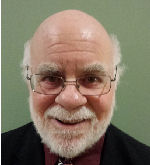
Dr. Jay Siegel
Dr. Siegel earned his PhD in analytical chemistry from George Washington University. He worked at the Virginia Bureau of Forensic Science and Metropolitan State College before joining the Michigan State University Criminal Justice Department. In 2004 he joined IUPUI as Director of the Forensic Science Program and became the Chair of the Department of Chemistry in 2008. He is now a retired consultant and the author of three books on forensic science and 30 publications. In 2009 he was honored as a Distinguished Fellow of the American Academy of Forensic Sciences.
Overview: Dr. Siegel's presentation covered what forensic science is, what forensic scientists do, how they analyze evidence, and issues in the field.
What is Forensic Science? The basic definition Dr. Siegel uses with his students is the "Application of science to legal matters". From a pragmatic and graphic viewpoint, a crime scene is analogous to an archeological dig - both tell a story, but cannot speak. Forensic science is the voice of the crime scene. The OJ Simpson crime scene was a classic example. TV programs like CSI and Law and Order have hyped interest in forensic science, but they take creative license which necessitates a lot of "unlearning" for new students.
What do they actually do? Forensic scientists try to "speak for the evidence", but do most of their work in the lab, not at the crime scene. All evidence is identified and analyzed (material, composition, etc.). This is necessary, but not sufficient. The real work is to associate evidence of the unknown (Q) with an object or material whose source is known or to a particular person (K) to determine provenance (source). This is always done by some sort of comparison. There are thousands of cases with evidence, but with no potential source for comparison.
Process of Association:
- Determine the physical and chemical properties of both known and unknown
- Categorize as common, uncommon, or unique
- Classify into progressively smaller groups by comparing properties
- Degree of association depends on unusual and unique properties
Examples:
- Materials: Drugs, glass, soils, have common properties, but impurities may them unusual.
- DNA type: considered so unusual that they are unique (statistically).
- Pattern evidence: fingerprints, firearms/tool marks, handwriting, blood splatter, shoeprints, and tire treads may sometimes be unique.
Associations are expressed as degrees of certainty:
- Individualize: Class of one > Provenance set
- Match: probability of a chance occurrence
- Similar to: inconclusive
- Cannot eliminate as a source: inconclusive
Individualization is the best case, but it has problems:
- Since truth is unknown, can't know from casework
- Can't test all objects, so ultimately unprovable
- Testing methods not validated
Methods of analysis for DNA are valid based on medical science. Likewise, chemical analysis is based on proven analytical chemistry. However, pattern evidence arose from police science and is not scientifically validated. An example of pattern evidence is firearm rifling, the "unique" markings on a bullet from the barrel of a specific firearm. Trouble is every barrel made with the identical rifling tool will be essentially the same - evidence not foolproof. Likewise, fingerprints have been accepted in courts as unique for over 100 yrs., but that is not scientifically proven. Many questions about validity are now being asked that should have been asked years ago. Presenting findings in court is a challenge as the average juror has only an 8th grade science education.
Bias in Forensic Science: Bias exists as:
- Situational: Forensic dept. is part of police dept.
- Cognitive: Analyst knows who is involved
- Confirmation: Ask for a second opinion/analysis, but disclose origin findings
A classic case of confirmation bias was the Brandon Mayfield scandal. Spain asked for FBI help in analysis of a partial fingerprint. The FBI found a "match" and confirmed it twice, but had the original results and therefore confirmed with bias the initial findings. All were wrong; Mayfield sued and won.
An example of cognitive bias: Five fingerprint analysts were given cases they had previously analyzed, but were told the situation was different. Three of the five had a different finding!!
In the Q&A, Dr. Siegel noted that biometrics (e.g., iris scan, facial recognition) are tools of the near future.
Notes by John Peer
Vol 90 No 42 - November 4, 2013
Impact of the Purdue School of Engineering and Technology at IUPUI
Presented By: David Russomanno, PhD, Dean, Purdue School of Engineering and Technology, IUPUI
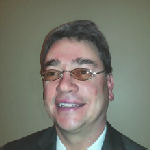
Dr. David
Russomanno
In 1969 the Indianapolis campuses of Purdue University and Indiana University were merged into a new entity called IUPUI. Indiana University assumed fiscal and administrative responsibilities while Purdue has academic oversight of Purdue courses, certificate and degrees. The campus has grown to over 30,000 students in 2012.
Purdue has three schools: Engineering, Technology and Science. The strategic plan is to compete at the highest level and strive for excellence and enhanced image and reputation. Enrollment has increased by 9% over two years. It is the largest school in the IUPUI campus with 1380 students in engineering, 600 in computer information technology and computer graphics and 529 students in engineering technology.
The average SAT for incoming freshmen is 1248. Only 17% are women and 1% are African American. Efforts to attract women and minorities are underway, with Minority Engineering Advancement Programs providing early experiences while those students are still in high school. Other programs such as "3 plus 2" programs in coordination with the Atlanta University Consortium, Marian University and Butler University have attracted several minority students to enroll at the Engineering School.
Bachelor of Science Degrees are offered in three engineering departments and four technology departments. The Motorsports Engineering Program is the only one of its kind in the United States. The music and arts technology department is one of a very few in the country. Masters of Science degrees are granted and PhD degrees are offered jointly with Purdue in Lafayette while the student is still in residence at IUPUI.
Recently U.S. News and World Report has ranked the Mechanical Engineering School as #8, Electrical Engineering as #10 and Biomedical Engineering as #23.
Strategic cooperation has been established with Sun Yat Sen University in China. Industry and research collaboration have resulted in multiple awards including $5 million from Toyota. Recent graduates from the school of engineering are gainfully employed with salaries comparable to graduates of other top universities.
The graduate school is ranked among the top 100 graduate engineering schools in the United States by U.S. News and World Report.
Notes by Gonz Chua
Vol 90 No 43 - November 11, 2013
U.S. Energy Policy and the Pursuit of Failure
Presented By: Dr. Peter Z. Grossman, Clarence Efroymson Professor of Economics, College of Business, Butler University
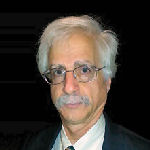
Dr. Peter
Grossman
Professor Grossman has written a book titled U.S. Energy Policy and the Pursuit of Failure. He claims that the U.S. energy policy under all presidents, from Nixon to Obama, is flawed.
On October 17, 1973, the Arab OPEC countries imposed an embargo against the U.S. because the U.S. supported Israel. Grossman stated that people jumped to the "obvious" conclusion that the embargo caused gas lines and American suffering, and revealed dependence on foreign energy supplies. People jumped to the conclusion we were running out of natural gas and oil. Therefore, there was a faulty conclusion that we needed energy independence.
Grossman noted that neither the U.S. nor the world was then about to run out of fossil energy reserves, as many then contended. Energy independence has had many definitions, ranging from producing all the energy we use in the U.S. to getting the energy from our allies in the Western Hemisphere. It remains a goal of the government: Energy independence sounds bold and decisive, means almost anything and takes longer than the next election cycle, getting elected officials off the hook, but there are no other ideas.
Energy independence was a goal of Carter, Reagan, Bush, Clinton, Bush and Obama. Politicians support the idea of energy independence, as it is a known political winner. Many benefit from the current government policy.
In his own words, Grossman's conclusions are:
- For the past forty years, it appears that policy makers have learned nothing from the past.
- That policy has always failed seemed irrelevant to each new Congress, to each new presidential administration and to each new agency head.
- It is as if officials are saying that they know their ideas will fail, but they will pursue them anyway because they cannot think of anything else to do.
- They will pursue a course of action that sounds pleasing to voters but has no chance of success. They will willfully pursue failure.
In answer to a question, Grossman had no opinion as to what the U.S. energy policy should be. However, after the meeting, he indicated that the US energy policy should be: Modest, and focused on the four "i's"--infrastructure, ideas, institutions and information.
Notes by Malcolm Mallette
Vol 90 No 44 - November 18, 2013
Dr. John Brinkley (1885-1942), first transplant surgeon and founder of border blaster radio in Del Rio, Texas
Presented By: Roger Robison, MD, retired, medical and radiation oncologist, medical historian
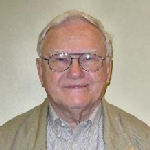
Dr. Roger Robison
Today's topic was the reputed "top fraud doctor," John R. Brinkley (1885-1942), MD, PhD, MC, LLD, DPH, ScD, NGS, and his seminal roles in both testes transplants and border-blaster radio. The foundation for medical quackery was laid years earlier by the repeal of medical licensure in the 1820s and 1830s, a movement that was promoted by President Andrew Jackson. This led to sectarianism and disarray in medical education and practice in the United States during the times of J. R. Brinkley. Many medical schools of this era did not even require a high school degree. Abe Flexner summarized the situation in his 1910 report (to the Carnegie Foundation) that recommended closure of all 32 sectarian, and 120 of 152 traditional medical schools in this country.
Indiana University Medical School, one of the 30 medical schools recommended to remain open, bucked these chaotic times by strengthening academic standards and medical educators under the guidance of Presidents David Jordan, MD (1889-1891) and William Bryan (1902-1937). Moreover, Morris Fishbein, MD (1889-1976), a Indianapolis resident native who rose to the highest ranks within the AMA, spent considerable time in his career on the elimination of quackery within medicine.
John R. Brinkley (JR) was born out of wedlock to a poor mountain doctor in Western North Carolina in 1885. His early experiences included medicine shows and vaudeville in the Appalachian mountains. He attended Bennet Medical School for 2 years in Chicago, but did not do well and became broke in July of 1911. In subsequent years he acquired false degrees and participated in fraudulent medical practice. During this time JR met and married Minnie Jones, the daughter of a rich physician in Chicago, despite the fact that he was already married and had children while living in North Carolina.
JR and his wife moved to Kansas City in 1915 and attended the Kansas City Eclectic School, where they reportedly purchased medical degrees for themselves for $100. He worked at a slaughterhouse where he became familiar with goats, a species which would play a key role in his future medical practices. After a short stint in the Army, JR moved to Milford Kansas and developed/promoted his practice of treating impotence by transplanting goat glands (testes) while at the Brinkley-Jones Hospital. In the 1920s he traveled to Chicago and developed one of the earliest public relations machines which included publications and P.R. men to highlight his claim of "goat gland babies." His claims of efficacy landed him a practice at Park Avenue Hospital where he achieved a degree of fame with 34 goat gland transplant operations. By 1922, JR came to the attention of Harry Chandler of the Los Angeles Times, who invited him to work in California. JR headed West, however his tenure there was brief due to the cancellation of his California medical license by none other than Dr. Morris Fishbein.
Following this setback, JR returned to Milford and bought a radio station (KFKB, 5000 watts) to further his local medical practice and public relations efforts. He developed quite a following in the Kansas farmland, eventually amassing approximately 1000 "prescription" stores that netted him $14,000 per week. He became a multimillionaire during this period. In 1930 JR attracted considerable attention when his radio station was rated #1 in the state. This notoriety did not serve him well, and ultimately resulted in expose's and the loss of his radio and medial licenses.
In 1931 JR sold his KFKB station and moved to Del Rio Texas to take on his next lucrative venture: border-busting radio stations. By crossing the border into Mexico for this business venture, he developed radio station XER, which far outstripped the wattage of US stations (reaching as high as 1 million watts in 1935 vs. the maximum of 5000 watts in the USA). JR's station reached all of 48 states and many other countries including Russia. His P.R. campaign and revenue supported a grand lifestyle in Del Rio Texas, where he purchased the Roswell Hotel for office space and built a huge mansion on a farm in the country.
The "end" for JR Brinkley and his house of cards began in 1938. It was in this year that Dr. M. Fishbein published an article on "Modern Medical Charlatans" in Hygeia. Furthermore, Dr. Fishbein and 20 other AMA staff sued JR for restraint of trade. A key evidence utilized by the AMA was the multitude of patient death certificates signed by Brinkley. In 1939 Brinkley brought countersuit for libel against Dr. Fishbein and the AMA, but he lost. In 1941 Brinkley was convicted of US Mail Fraud, and in 1942 John R. Brinkley died, bringing to an end the age of flimflam he had perfected.
Notes by Ray Kauffman
Vol 90 No 45 - November 25, 2013
The Story of Buddy "L"
Presented By: Ann Ericsson, the daughter of Arthur ("Buddy") Brown Lundahl
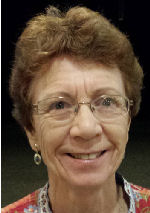
Ann Ericsson
Buddy "L" toys were originally manufactured by the Moline Pressed Steel Company, started by Fred A. Lundahl in 1910 (our speaker's grandfather).
The company originally manufactured fenders and other stamped body parts for the automobile industry. The company primarily supplied parts for the McCormack-Deering line of farm implements and the International Harvester Company for its trucks. Moline Pressed Steel did not begin manufacturing toys until 1921. Mr. Lundhal wanted to make something new, different, and durable for his son Arthur. As Fred Lundahl used to manufacture trucks for International Harvester, he started by making a toy dump truck out of steel scraps for his son Buddy.
Soon after, he started selling Buddy L "toys for boys", made of pressed steel. Buddy L made such products as toy cars, dump trucks, delivery vans, fire engines, construction equipment, and trains. Many were large enough for a child to straddle, propelling himself with his feet, others were pull toys. The stout trucks produced were capable of supporting more than two hundred pounds. A pioneer in the steel-toy field, Lundahl persuaded Marshal Fields and FAO Schwartz to carry his line. He did very well until the Depression and along with so many other companies, Buddy L encountered hard times.
Mr. Lundahl died 1/14/1930, two weeks after surgery for cancer of the colon. In 1930, after failing twice to pay taxes, the control of the company passed to the Board of Directors.
Today, the Buddy L toys are in great demand and command prices in the hundreds of dollars. The initial truck sold for $ 6.00. There is a museum of Buddy L toys in Davenport, Iowa
From 1976 to 1990, Buddy L was owned by Richard Keats, a well-known New York toy designer who went to work for Buddy L the day after he graduated from Brown University in 1948. In 1990, Keats sold Buddy L to Empire Industries of Boca Raton, Florida, a subsidiary of Empire of Carolina.
In the 1990s, Buddy-L made a wet version of T-ball.
Notes by Jack Slickenmyer
Vol 90 No 46 - December 2, 2013
Tour of the Kokomo Opalescent Glass Company
Presented By: Opalescent Glass Company Guides
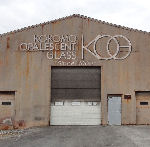
Have you ever wondered how the glass was made that Tiffany used for years in all those lampshades that they sold as Tiffany lamps? Have you ever wondered what it would be like to walk into a plant operating in the early 1900s? If you had been one of the 51 Scientech people who attended today's tour you would have the answers to these questions. All this can be seen at the Kokomo Opalescent Glass Company located in, of course, Kokomo Indiana. This company has a rich history that goes back many years.
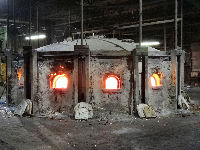
The Opalescent Glass Company was founded in 1888 at the time of a gas boom in north central Indiana. Free gas was provided as an incentive to bring the plant to Kokomo. Not only did it motivate the creation of this company but thirteen other glass companies as well. Given that glass is made primarily from sand, the major cost component is energy, so companies are extremely sensitive to energy costs. The name Kokomo was added to the company name early in the twentieth century. The factory still produces glass the way it did over one hundred years ago in a factory that is ancient. Originally, Tiffany's purchased 10,000 pounds of stained glass from them to give them a significant start-up boost. Today the company sells stained glass to customers around the world--much of it over the Internet. During the tour we saw how sheet glass is made, cut and stored, and also got a chance to see an artisan doing glass blowing. There was a small gift shop at the end of the tour.
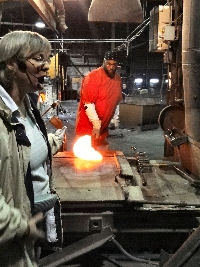
Here are some tidbits from today's tour:
- Once the Indiana free gas incentive stopped (25 years later) glass companies abandoned Kokomo and moved to West Virginia - the exception is this company.
- There are only five such glass manufactures in the country today.
- The company is currently privately owned by four different families.
- This company has 48 employees including 3 who blow glass and 14 artisans who do restorations, create new items and manufacture items for sale in the gift shop.
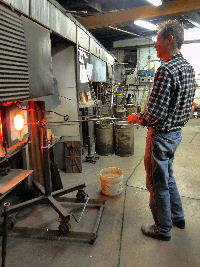
- They keep twelve different color pot ovens running 24/7. Once the glass in the pot is exhausted, they may switch colors; it all depends on their orders in hand.
- Once they load the ingredients of a color into the furnace it must "cook" for 17 hours before they can use the glass.
- A typical month's gas bill will run in the $50,000 range.
- They offer 19 different glass textures, 2200 different colors in 7 different densities.
- A 32" by 32" sheet of glass in a standard color costs $57.00; a nonstandard color may cost up to $120.00.
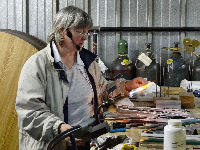
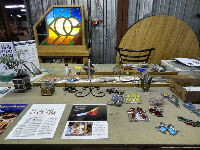
After the tour the group had lunch at a local Italian restaurant.
As usual, Jim Bettner is to be commended for another flawless tour with every detail carefully attended to.
Click HERE to view the pictures taken during this tour
Notes by Dick Garrett
Vol 90 No 47 - December 9, 2013
The Shepherd Singers Perform a Holiday Concert
Conducted By: Rev. Robert A. Schilling, retired organist and choirmaster, Associate Pastor, North United Methodist Church.
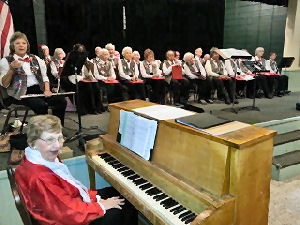
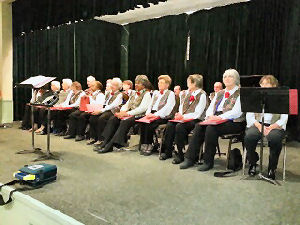
The program was presented by the Shepherd's Singers from the Mid-North Shepherd's Center, 3808 N. Meridian St. The Director of the choir is Dr. Robert Schilling. The choir was accompanied by Shirley Marshall on the piano and Betsy Baltz playing the flute.
The performance included pieces selected from the following repertoire:
1. Most Wonderful Time of the Year - Eddie Pola and George Wyle
2. Deck the Hall with Haydn - F. J. Haydn, arr. Greg Gilpin
3. Celebration of Light (Hanukkah song) - Joseph M. Martin
4. Nutcracker Jingles - Tchaikovsky & Pierpont, arr. Bridwell
5. AUDIENCE SING-ALONG: White Christmas
6. The Bells of Christmas Medley - Four bell carols, arr. Greg Gilpin
7. Shepherd's Pipe Carol - John Rutter
8. INSTRUMENTAL DUET - Christmas Angels, arr. Joel Raney
9. Winter Song - Richard Hovey & Frederic Field Bullard
10. A Musicological Journey Through the Twelve Days of Christmas
1. In the style of Gregorian chant (6th C. Rome)
2. In the style of Guillaume Dufay (15th C. France)
3. In the style of Giovanni da Palestrina (16th C. Italy)
4. Quote from Gloria by Antonio Vivaldi (17th C. Italy)
5. In the style of G. F. Handel (18th C. Germany)
6. In the style of W. A. Mozart (18th C. Austria)
7. Quote from "The Swan" by Camille Saint-SaŽns (19th C. France)
8. Quote from "Ride of the Valkyries," Richard Wagner (19th C. Germany)
9. Quote from "The Emperor Waltz," Johann Strauss, Jr. (19th C. Austria)
10. Quote from "Dance of the Hours" by Amilcare Poncielli (19th C. Italy)
11. Quote from "Dance of the Reed Flutes," P.I.Tchaikowsky (19th C. Russia)
12. Quote from "The Stars and Stripes Forever," J. P. Sousa (19th C. USA)
11. We Wish You a Merry Christmas - English folk song
Notes by Bill Elliott
Vol 90 No 48 - December 16, 2013
Elwood Haynes, Scientech Club Charter Member
Presented By: William Dick, MD
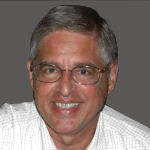
William Dick, MD
When Bill Stanley and I interviewed Harold Wesselman a few years ago, he surprised us with the statement that Elwood Haynes was our most important member. This comment is from a former Eli Lilly and Co. chemist who met with Mr. Lilly in the lab at the company. Mr. Wesselman was a Scientech Club member since 1959, president in 1969 and was also secretary for 15 years.
After some research, we found why Harold felt that way. Mr. Haynes was a dynamo - a gas company executive, research chemist, automaker, and philanthropist. Indiana then held the largest natural gas field in the U.S. Mr. Haynes was known as the "Father of the Gas Boom" in Indiana.
Natural gas was found in NY State in 1921. Haynes later visited the gas wells in northwest Ohio. He analyzed wells and the types of stone. Moreover, he gave lectures to the public on natural gas and helped communities organize their gas delivery. He also invented a forerunner of a home thermostat. He urged people not to waste the natural gas. The Gas Boom brought many factories to the State, especially glass companies, which needed high heat to make their product. The Ball brothers are a good example.
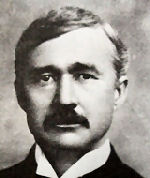
Elwood Haynes
Elwood Haynes was born in Portland, IN in 1857. His father was an attorney who valued education for his children. Haynes became interested in metal alloys when he read a chapter in his sister's college textbook. He attended the Worchester Institute of Industrial Science. His graduate thesis was "The Effect of Tungsten on Iron and Steel."
Natural gas was found near Portland IN in 1886. With a group of investors, Haynes founded Portland Natural Gas and Oil Co. In 1890, working for another company, he built a gas pipeline to Chicago. Mr. Haynes married Bertha Lanterman in 1887 and two of their children survived to adulthood. In 1890, they moved to Kokomo and Haynes began working on an automobile. In 1891, he worked with Elmer and Edgar Apperson in order to build automobiles. On 4 July 1894, Haynes drove a car on the Pumpkinville Pike at a speed of 12-14 miles per hour. It was the first purpose-built automobile driven by an American; it was not a converted horseless carriage.
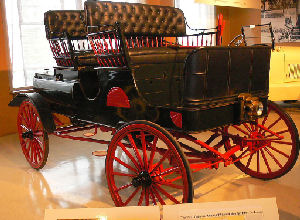
Haynes Auto 1901
He invented pneumatic tires, used aluminum in autos, pioneered the first muffler and used a successful carburetor. Haynes and the Appersons built cars as a team until 1902, when they separated. Sales peaked in 1916, the year that Haynes built the home that is today the Haynes Museum. Haynes was a big booster for automobile clubs and endurance races. Then he returned to his first love - metallurgical research.
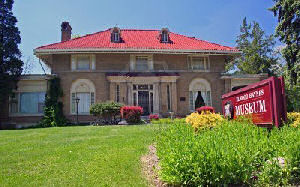
Elwood Haynes Museum
In 1912, he invented stellite, a cobalt-chromium alloy. His next invention was stainless steel. It was used in medical and dental instruments and a new stainless steel cutlery set built for his wife. His materials were used in WW I and, of course, in the space industry later in the 20th century. Haynes continued making luxury autos and a few can be seen at the Haynes Museum in Kokomo. The company ended business in 1925. Haynes was very kind to his workers: he brought in fruit and vegetables for sale on Friday, which was payday.
Haynes became a very wealthy man, but some of that wealth was lost in multiple patent lawsuits, etc. Mr. Haynes and the Duryea brothers fought it out for years in claiming construction of the first car. Elwood Haynes was a philanthropist for Kokomo and other places: The Presbyterian Church, Worchester Institute, founded the YMCA in Kokomo, and the Indiana State Board of Education.
Click HERE to view the Power Point slides used in this presentation.
Notes by Bill Dick